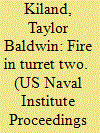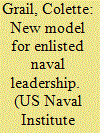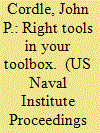| Srl | Item |
| 1 |
ID:
124077


|
|
|
|
|
| Publication |
2012.
|
| Summary/Abstract |
The article presents the author's comments on the U.S. Navy's policies which have confused sailors and increased the already significant level of uncertainty and stress among Navy families. The author suggests that commanding officers must exercise their moral obligation to adequately document sailors' performance. The author considers the Retention Honor Roll as a good example of the current institutional manpower doublespeak prevalent in the service.
|
|
|
|
|
|
|
|
|
|
|
|
|
|
|
|
| 2 |
ID:
124119


|
|
|
|
|
| Publication |
2012.
|
| Summary/Abstract |
The article focuses on the detonation of a faulty projectile on the U.S. Ship Newport News that left 20 sailors dead and 36 injured on September 30, 1972. It is reported that at about 0100 in the night an eight-inch guns fired followed by the announcement ordering the entire crew to general quarters. Comments on a 8-inch projectile in the bore of the center gun of Turret Two that exploded prematurely, setting off several casings in the powder hoists are also included.
|
|
|
|
|
|
|
|
|
|
|
|
|
|
|
|
| 3 |
ID:
123953


|
|
|
|
|
| Publication |
2012.
|
| Summary/Abstract |
The article reports that using less but better prepared engineers will cut the cost and improve readiness of the U.S. Navy. It states that minimum manning is promising, however, there is a downward trend in mission readiness. It mentions that technological advances require more skilled workforce, and sailors should be technically literate and have strong problem solving, decision making and communication skills.
|
|
|
|
|
|
|
|
|
|
|
|
|
|
|
|
| 4 |
ID:
124034


|
|
|
|
|
| Publication |
2012.
|
| Summary/Abstract |
The article reports that the Chief Petty Officers of the U.S. Navy are the backbone in connecting officer leadership to the working sailor, and the transition is a progress of skills over time. It states that to continue with such leadership, it is important to use accurate and timely information both up and down the chain of command. It mentions that numerical assessment is an important role in the process of decision making.
|
|
|
|
|
|
|
|
|
|
|
|
|
|
|
|
| 5 |
ID:
124123


|
|
|
|
|
| Publication |
2012.
|
| Summary/Abstract |
The article focuses on leadership tools including Ensign 101, Spot Navy Achievement Medal and Future Chief Petty Officer Association (FCPOA) that are reportedly helpful to young leaders of the U.S. Navy in motivating sailors to achieve their goals. The Ensign 101 list is the product of retired Captain James P. Ransom while the Spot Navy Achievement Medal is given for any act deserving recognition. Comments on FCPOA that focuses on leadership development and boosts morale are also included.
|
|
|
|
|
|
|
|
|
|
|
|
|
|
|
|
| 6 |
ID:
086266


|
|
|
|
|
| Publication |
2009.
|
| Summary/Abstract |
The introduction of the steamships on a large scale in the late 19th century saw African and Asian sailors becoming a central component of the workforce of the British merchant marine. This development was met with considerable resistance from British seamen who saw these workers as a cheap labour force that would undermine their established position. This article interprets the steam empire as a set of overlapping webs, comprising the shipping companies, British diasporic labour and Indian Ocean seafarers. It traces how a racialized politics was generated within these webs, and the major conflicts to which this gave rise.
|
|
|
|
|
|
|
|
|
|
|
|
|
|
|
|